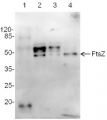Loading controlsIn biology there are no universal controls. One has to determine a priori what does not change in one's test conditions and use that as a control. The choice of appropriate house-keeping protein would depend upon the particular experiment, and it needs to be confirmed. House-keeping proteins cannot be used for normalization if there is a suspicion that experimental conditions are affecting their expression. Other possible internal controls • Total protein (express fmol target protein/µg total protein) For short term experiments, Rubisco protein makes a good loading control as its turnover is slow. However, Rubisco level do vary with nutrient levels, particularly nitrogen.
| 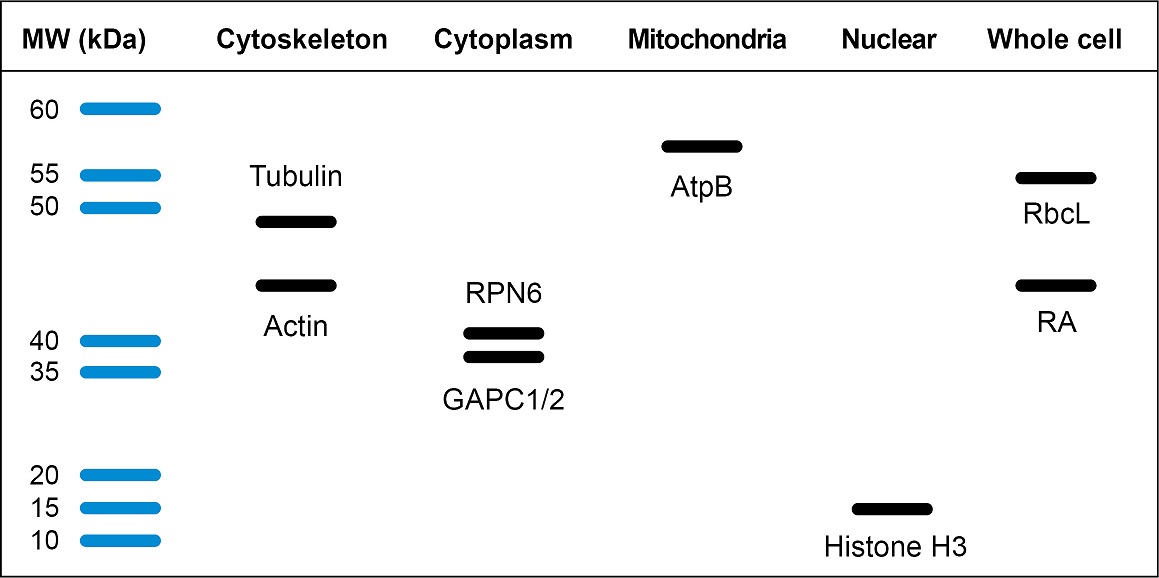 Loading control guide |

AS13 2640 | Clonality: Polyclonal | Host: Rabbit | Reactivity: Actinidia sp., Agostis stoloniferacv. ‘Penncross’,Arabidopsis thaliana, Brassica sp., Cannabis sativa L., Cucumis sativus, Cynara cardunculus, Glycine max, Hordeum vulgare, Nicotiana tabacum, Phaseolus vulgaris, Phoenix dactylifera, Picrorhiza kurroa, Raphanus sativus, Setaria italica, Solanum tuberosum, Triticum aestivum, Zea mays

AS21 4615 | Clonality: Monoclonal | Host: Mouse recombinant antibody (animal-free technology) | Reactivity: Arabidopsis thaliana, Eschscholzia californica, Medicago sativa, Nicotiana benthamiana, Nicotiana tabacum, Salvia plebeian, Zea mays
This product replaces AS16 4111

AS03 030 | Clonality: Polyclonal | Host: Chicken | Reactivity: [global antibody] for plant and bacterial F-type ATP synthases
Benefits of using this antibody

AS05 085 | Clonality: Polyclonal | Host: Rabbit | Reactivity: [global antibody] for plant, green alga, animal and bacterial F-type ATP synthases
Benefits of using this antibody

AS16 3976 | Clonality: Polyclonal | Host: Rabbit | Reactivity: Arabidopsis thaliana, Brassica oleracea var. botrytis cv. ’Diadom’, [compartment marker] of mitochondrial inner membrane
Benefits of using this antibody
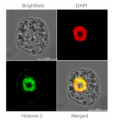
AS10 710A | Clonality: Polyclonal | Host: Rabbit | Reactivity: A. thaliana, C. reinhardtii, S. lycopersicum, V. faba, P. patens, S. europaea, Z. mays, Ch. reinhardtii | cellular [compartment marker] of nucleoplasm

AS15 2855 | Clonality: Polyclonal | Host: Chicken | Reactivity: A. thaliana, C. reinhardtii, L. esculentum, T. aestivum | cellular [compartment marker] of nucleoplasm

AS10 710 | Clonality: Polyclonal | Host: Rabbit | Reactivity: A. thaliana, B. cinerea, C. reinhardtii, G. hirsutum, H. vulgare, S. lycopersicum, V. faba, P. tricornutum, P. patens, S. europaea, Z. mays | cellular [compartment marker] of nucleoplasm

AS10 710-ALP | Clonality: Polyclonal | Host: Rabbit | Reactivity: A. thaliana, S. lycopersicum, V. faba, P. patens, S. europaea, Z. mays, Ch. reinhardtii | cellular [compartment marker] of nucleoplasm

AS10 710B | Clonality: Polyclonal | Host: Rabbit | Reactivity: A. thaliana, S. lycopersicum, V. faba, P. patens, S. europaea, Z. mays, Ch. reinhardtii | cellular [compartment marker] of nucleoplasm




AS10 710-HRP | Clonality: Polyclonal | Host: Rabbit | Reactivity: A. thaliana, S. lycopersicum, V. faba, P. patens, S. europaea, Z. mays, Ch. reinhardtii | cellular [compartment marker] of nucleoplasm

AS06 142-23 | Clonality: Polyclonal | Host: Rabbit | Reactivity: A. thaliana, Ch. reinhardtii, P. banksiana. , S.oleracea, T. aestivum
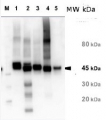
AS10 700 | Clonality: Polyclonal | Host: Rabbit | Reactivity: A. thaliana, Caesalpinia pulcherrima, C. sativa, C. reinhardtii, H. spontaneum, F. pRatensis, G. max, G. hirsutum, G. barbadense, L. perenne, N. oceanica, N. tabacum, O. sativa, P. balsamifera, R. discolor, S. lycopersicum, Z. mays, T. salsuginea, red sulfur bacterium T. sp. Cad16 (isolated from Lake Cadagno)
Replaced by AS22 4868

AS01 017 | Clonality: Polyclonal | Host: Hen | Reactivity: [global antibody] for higher plants, algae, cyanobacteria | cellular [compartment marker] of plastid stroma
Benefits of using this antibody

AS03 037 | Clonality: Polyclonal | Host: Rabbit | Reactivity: global antibody and compartment marker for higher plants, lichens, algae, cyanobacteria, dinoflagellates, diatoms
Benefits of using this antibody



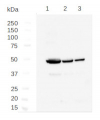
AS10 680 | Clonality: Polyclonal | Host: Rabbit | Reactivity: A. thaliana, C. reinhardii, E. gracilis, H. vulgare, O. sativa, Setaria italica, Zea mays




